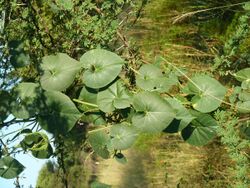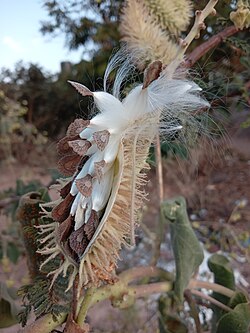Biology:Pergularia daemia
| Pergularia daemia | |
|---|---|

| |
| In Limpopo, South Africa | |
| Scientific classification | |
| Kingdom: | Plantae |
| Clade: | Tracheophytes |
| Clade: | Angiosperms |
| Clade: | Eudicots |
| Clade: | Asterids |
| Order: | Gentianales |
| Family: | Apocynaceae |
| Genus: | Pergularia |
| Species: | P. daemia
|
| Binomial name | |
| Pergularia daemia (Forssk.) Chiov.
| |
| Synonyms | |
| |
Pergularia daemia, the trellis-vine, is a hispid, perennial vine in the family Asclepiadaceae, with an extensive range in the Old World tropics and subtropics.[citation needed] It has been used traditionally to treat a number of ailments.[citation needed] It is sometimes called atufa.[1]
Range and habitat
It occurs from the Malay Peninsula to Burma, India , Sri Lanka, Pakistan , Afghanistan through Arabia and Egypt to central and southern Africa.[2] It is found along roadsides, in woodland or along riparian forest fringes.[3]
Description
The opposite[citation needed] and broadly ovate to suborbicular leaves are very variable in size, with petioles of varying length. The leaves are almost glabrous above and velvety below.[2]
In the northern hemisphere the flowers appear from mid to late winter, and these are carried on lateral cymes. The flower corolla forms a greenish-yellow or dull white tube.[2] The fruit mature after some 13 to 14 months[citation needed] when they release ovate seeds covered with velvety hairs.[2]
Phytochemical properties
Terpenoids, flavonoids, sterols and cardenolides are among the chemicals that have been isolated from either the leaves, stems, shoots, roots, seeds or fruit.[citation needed] Traditionally it has been used as an anthelmintic, laxative, antipyretic and expectorant, besides treatment of infantile diarrhoea, malarial intermittent fevers, toothaches and colds.[citation needed] Studies have shown hepatoprotective, antifertility, anti-diabetic, analgesic, antipyretic and anti-inflammatory properties of substances in its aerial parts.[citation needed]
Associated species
The larvae of the African monarch butterfly (Danaus chrysippus aegyptius) feed on this species.
References
- ↑ Odugbemi, Tolu O; Akinsulire, Odunayo R; Aibinu, Ibukun E; Fabeku, Peter O (2006-11-13). "Medicinal Plants Useful for Malaria Therapy in Okeigbo, Ondo State, Southwest Nigeria". African Journal of Traditional, Complementary and Alternative Medicines 4 (2): 191–198. doi:10.4314/ajtcam.v4i2.31207. ISSN 0189-6016. PMID 20162091.
- ↑ 2.0 2.1 2.2 2.3 "Pergularia daemia (Forssk.) Chiov.". Flora of Pakistan. efloras.org. http://www.efloras.org/florataxon.aspx?flora_id=5&taxon_id=242424223. Retrieved 26 March 2013.
- ↑ Hyde, M.. "Pergularia daemia (Forssk.) Chiov.". Flora of Zimbabwe. http://www.zimbabweflora.co.zw/speciesdata/species.php?species_id=147070. Retrieved 15 March 2013.
External links
Wikidata ☰ Q13940293 entry
 |


